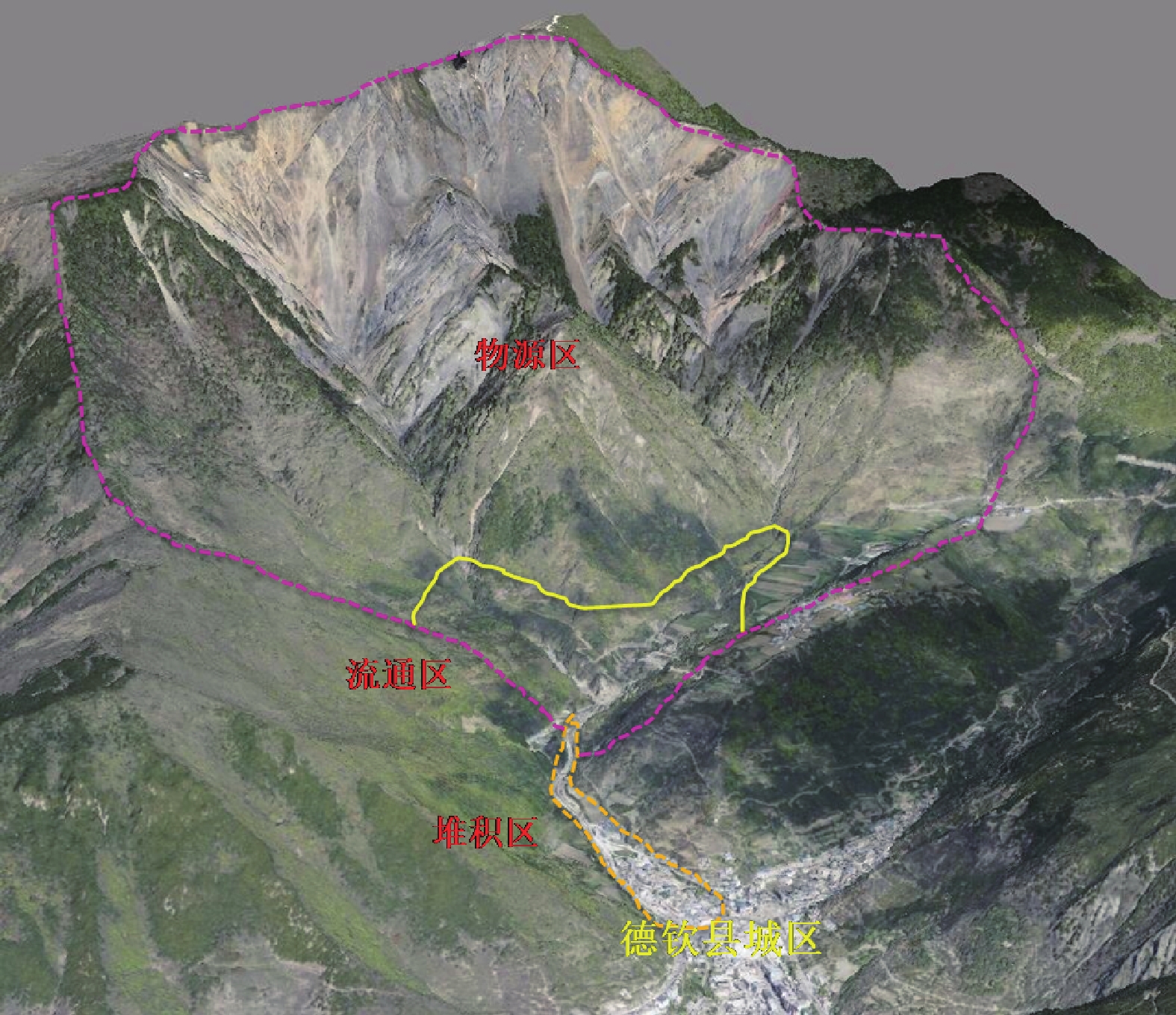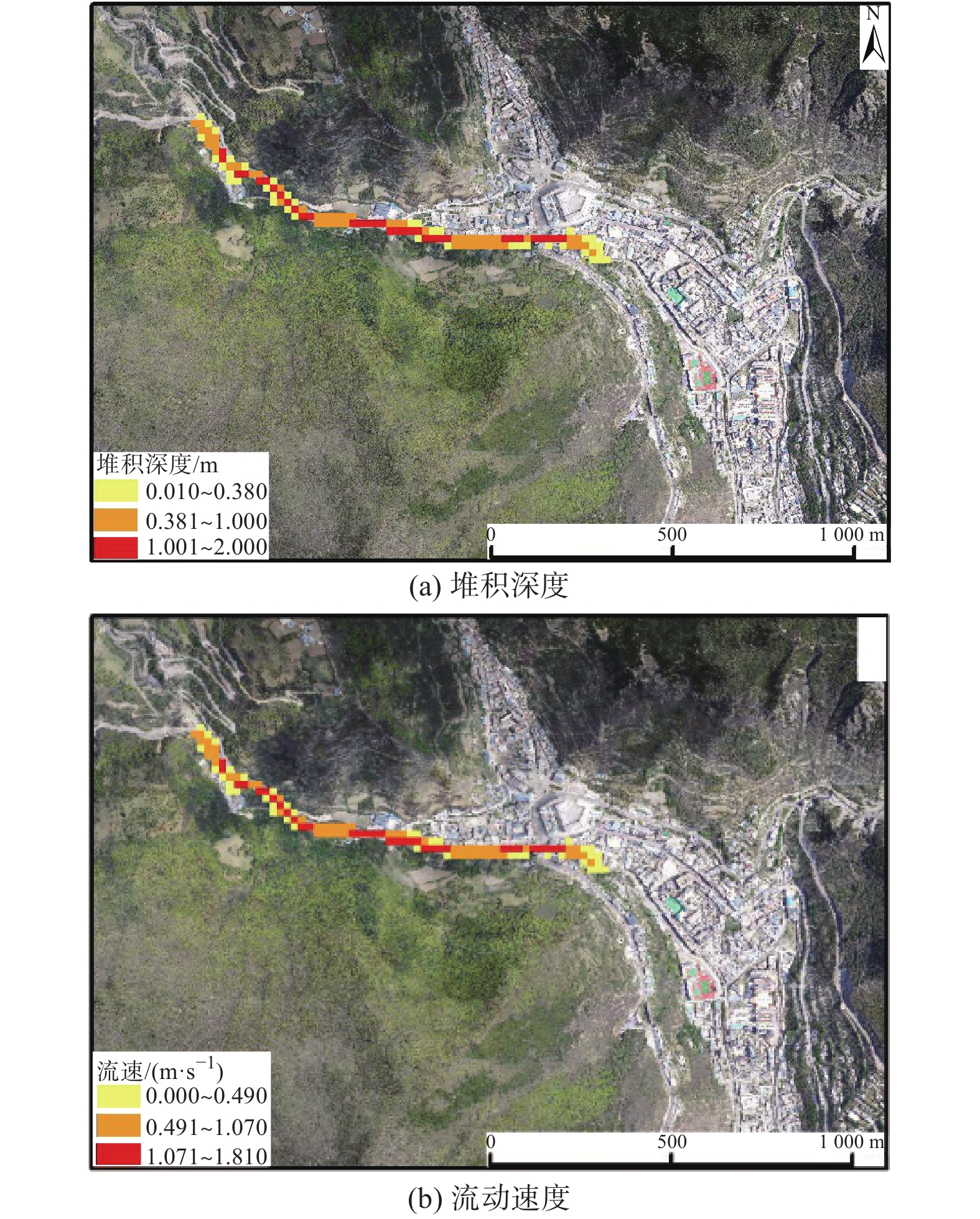A study of the disaster model and movement process simulation of debris flow in the Zhixi River of Deqin County
-
摘要:
云南省德钦县曾多次暴发较大规模的泥石流,是云南遭受地质灾害最严重的地区之一。根据直溪河泥石流的分区、物源、流体和堆积等特征,首先确定了直溪河泥石流的5种成灾模式:崩塌-碎屑流、岩质滑坡-碎屑流、土石混合体滑坡-碎屑流、松散堆积层-基岩接触面滑坡-碎屑流和松散堆积层内滑坡-碎屑流;其次,采用FLO-2D模型对直溪河在10年、20年、50年和100年一遇暴雨周期下发生泥石流时的运动情况进行模拟,定量分析了不同降雨重现期的最大流速、最大堆积深度、冲出沟口堆积距离和体积规模。结果表明:该泥石流暴发时具有启动加速度大、流速快、破坏力强、流通区长的特点;当100年一遇的泥石流发生时,其最大流速达到了3.07 m/s;最大泥深为2.27 m;泥石流冲出方量为84419 m3;致灾面积达到91600 m2。研究结果可为直溪河泥石流灾害防治与治理提供数据参考,为德钦县防灾减灾工程设计提供依据。
Abstract:Deqin County is one of the areas suffering the most serious geological disasters in Yunnan Province. Based on the development characteristics of the debris flow in the Zhixi River, this study identifies five disaster-generating modes for the debris flow in the Zhixi River: Collapse - clastic flow, rock landslide-clastic flow, soil-rock mixture landslide-clastic flow, loose accumulation layer -bedrock contact surface landslide-clastic flow and landslide in loose accumulation layer-clastic flow. The FLO-2D model is used to simulate the debris flow movement in the Zhixi River under the rainstorm cycle of 10, 20, 50 and 100 years, and the maximum flow velocity, the maximum accumulation depth, the accumulation distance and the volume scale in different rainfall return periods are quantitatively analyzed. The results show that the debris flow is characterized by high acceleration, fast velocity, strong destructive force, and long circulation area when it erupts. When the debris flow occurs once in 100 years, its maximum velocity reaches 3.07 m/s, the maximum mud depth is 2.27 m , the volume of debris flow washed out is 84419 m3, and the disaster area reaches 91600 m2. The results provide quantitative data reference for the prevention and control of debris flow disasters in Zhixi River, and also provides an important basis for the design of disaster prevention and mitigation projects in Deqin County.
-
Key words:
- Zhixi River /
- debris flow /
- disaster model /
- outbreak cycle /
- FLO-2D /
- disaster prevention and mitigation
-

-
表 1 直溪河泥石流沟松散固体物储量表
Table 1. Calculations of the loose solids reserves in the debris flow gully of the Zhixi River
物源类型 滑坡 崩塌 坡积物 残坡积物 洪积物 弃渣 合计 面积/(104 m2) 13 24 147 521 31 2 738 体积/(104 m3) 127 360 326 662 775 5 2255 可移储量/(104 m3) 29 18 22 138 9 2 218 一次最大可移储量/(104 m3) 1.46 0.09 0.73 0.69 0.49 0.19 3.65 表 2 4种工况具体降雨情况
Table 2. Precipitation situation of four kinds of working conditions
工况 最大日降雨量/mm 降雨强度/(mm·h−1) P=10% 56.19 23.04 P=5% 63.03 25.84 P=2% 71.64 29.37 P=1% 77.94 31.96 表 3 泥石流参数取值
Table 3. Parameters for the debris flow
参数 重度/(t·m−3) 体积浓度 曼宁系数 宾汉屈服系数 宾汉黏滞系数 层流阻滞系数 放大因子BF 



取值 2.7 0.61 0.3、0.35 0.0811 13.72 0.00462 11.24 3000 2.56 表 4 不同降雨频率下直溪沟泥石流模拟结果
Table 4. Simulation results of debris flow in Zhixi Gully under different rainfall frequencies
爆发周期 冲出体积/m3 冲出距离/m 致灾(堆积区)面积/m2 堆积区泥石流体积/m3 堆积最大深度/m 最大流速/(m·s−1) P=10% 34290 1272 23200 15513 2 1.81 P=5% 41892 1334 33200 21580 2.21 1.91 P=2% 47823 1447 38800 25491 2.35 1.96 P=1% 84419 1850 91600 59814 3.07 2.27 -
[1] 万石云, 李华宏, 胡娟. 云南省滑坡泥石流灾害危险区划[J]. 灾害学,2013,28(2):60 − 64. [WAN Shiyun, LI Huahong, HU Juan. Hazard zoning of landslide and debris flow disasters in Yunnan Province[J]. Journal of Catastrophology,2013,28(2):60 − 64. (in Chinese with English abstract) doi: 10.3969/j.issn.1000-811X.2013.02.013
[2] 王研. 云南省德钦县一中河泥石流形成机制和防治对策[D]. 北京: 中国地质大学(北京),2016.
WANG Yan. Formation mechanism and prevention measures of Debris flow in Yizhong River, Deqin County, Yunnan Province [D]. Beijing:China University of Geosciences (Beijing),2016.(in Chinese with English Abstract) ]
[3] 王俊豪, 金华丽, 倪天翔, 等. 基于层次分析法的模糊综合评判模型在康乐县泥石流沟危险性评价中的应用[J]. 中国地质灾害与防治学报,2017,28(3):52 − 57. [WANG Junhao, JIN Huali, NI Tianxiang, et al. The application of fuzzy comprehensive evaluation model based on analytic hierarchy process in risk assessment of debris flow gully in Kangle County[J]. The Chinese Journal of Geological Hazard and Control,2017,28(3):52 − 57. (in Chinese with English abstract)
[4] 崔传峰, 王俊豪, 崔志超, 等. 基于灰色可拓模型的洮河下游泥石流易发性评价[J]. 中国地质灾害与防治学报,2019,30(6):40 − 48. [CUI Chuanfeng, WANG Junhao, CUI Zhichao, et al. Evaluation of debris flow susceptibility in the lower reaches of Taohe River based on grey extension model[J]. The Chinese Journal of Geological Hazard and Control,2019,30(6):40 − 48. (in Chinese with English abstract)
[5] 邵海, 魏云杰, 黄喆, 等. 新疆伊宁克孜勒赛黄土滑坡堵溃型泥石流成灾模式[J]. 中国地质灾害与防治学报,2018,29(6):40 − 46. [SHAO Hai, WEI Yunjie, HUANG Zhe, et al. Kezilesai loess landslide dam-breaking debris flow hazards model in Yining County, Xinjiang[J]. The Chinese Journal of Geological Hazard and Control,2018,29(6):40 − 46. (in Chinese with English abstract)
[6] 管建军, 王俊豪, 王双亭, 等. 无人机倾斜摄影在黄土地区泥石流灾害调查与评价中的应用[J]. 中国地质灾害与防治学报,2017,28(4):137 − 145. [GUAN Jianjun, WANG Junhao, WANG Shuangting, et al. Application of UAV oblique photography in investigation and evaluation of debris flow disasters in loess area[J]. The Chinese Journal of Geological Hazard and Control,2017,28(4):137 − 145. (in Chinese with English abstract)
[7] HSU Y C, LIU K F. Combining TRIGRS and DEBRIS-2D models for the simulation of a rainfall infiltration induced shallow landslide and subsequent debris flow[J]. Water,2019,11(5):890. doi: 10.3390/w11050890
[8] 方群生, 陈志和, 唐川, 等. 基于FLO-2D数值模拟震区急陡型泥石流冲出量: 以瓦窑沟为例[J]. 中山大学学报(自然科学版),2020,59(3):23 − 3. [FANG Qunsheng, CHEN Zhihe, TANG Chuan, et al. Numerically simulating the runout volume of debris flow at urgent steep gully in the earthquake areas based on FLO-2D: Illustrated with a case of Wayao gully[J]. Acta Scientiarum Naturalium Universitatis Sunyatseni,2020,59(3):23 − 3. (in Chinese with English abstract)
[9] 张鹏, 马金珠, 舒和平, 等. 基于FLO-2D模型的泥石流运动冲淤数值模拟[J]. 兰州大学学报(自然科学版),2014,50(3):363 − 368. [ZHANG Peng, MA Jinzhu, SHU Heping, et al. Numerical simulation of erosion and deposition debris flow based on FLO-2D Model[J]. Journal of Lanzhou University (Natural Sciences),2014,50(3):363 − 368. (in Chinese with English abstract)
[10] 黄勋, 唐川, 周伟. 基于数值模拟的暴雨泥石流暴发频率计算模型[J]. 工程地质学报,2014,22(6):1271 − 1278. [HUANG Xun, TANG Chuan, ZHOU Wei. Numerical simulation of occurrence frequency estimation model for debris flows[J]. Journal of Engineering Geology,2014,22(6):1271 − 1278. (in Chinese with English abstract)
[11] 杜雪剑, 孙书勤, 赵峥, 等. 基于FLO-2D模型的红椿沟泥石流工程治理效果研究[J]. 地球与环境,2016,44(3):376 − 381. [DU Xuejian, SUN Shuqin, ZHAO Zheng, et al. Research on engineering control effect on Hongchun gully debris based on FLO-2D model[J]. Earth and Environment,2016,44(3):376 − 381. (in Chinese with English abstract)
[12] 王骏, 丁明涛, 黄英. 基于FLO-2D的联合溪沟泥石流运动特征及防治对策[J]. 西南科技大学学报, 2016, 31(2): 59-66
Wang Jun, Ding Mingtao, Huang Ying Debris flow motion feature and control measures of Lianhexi valley based on FLO-2D[J]. Journal of Southwest University of Science and Technology, 2016, 31(2): 59-66. ( in Chinese with English abstract)
[13] 贾涛, 唐川, 王纳纳. 基于FLO-2D与冲量模型的泥石流危险度分区方法及应用[J]. 水电能源科学,2015,33(2):152 − 155. [JIA Tao, TANG Chuan, WANG Nana. Method and application of debris flow hazard zoning based on FLO-2D and impulse model[J]. Water Resources and Power,2015,33(2):152 − 155. (in Chinese with English abstract)
[14] LIN J Y, YANG M D, LIN B R, et al. Risk assessment of debris flows in Songhe Stream, Taiwan[J]. Engineering Geology,2011,123(1/2):100 − 112.
[15] 梁鸿熙, 尚敏, 徐鑫. 基于FLO-2D数值模拟的泥石流流动与堆积影响因素研究[J]. 工程地质学报,2016,24(2):228 − 234. [LIANG Hongxi, SHANG Min, XU Xin. Research on the influence factors of flow and deposition of debris flow based on the FLO-2D simulation[J]. Journal of Engineering Geology,2016,24(2):228 − 234. (in Chinese with English abstract)
[16] 侯圣山, 曹鹏, 陈亮, 等. 基于数值模拟的耳阳河流域泥石流灾害危险性评价[J]. 水文地质工程地质,2021,48(2):143 − 151. [HOU Shengshan, CAO Peng, CHEN Liang, et al. Debris flow hazard assessment of the Eryang River watershed based on numerical simulation[J]. Hydrogeology & Engineering Geology,2021,48(2):143 − 151. (in Chinese with English abstract)
[17] PENG S H, LU S C. FLO-2D simulation of mudflow caused by large landslide due to extremely heavy rainfall in southeastern Taiwan during Typhoon Morakot[J]. Journal of Mountain Science,2013,10(2):207 − 218. doi: 10.1007/s11629-013-2510-2
[18] WU Y H, LIU K F, CHEN Y C. Comparison between FLO-2D and Debris-2D on the application of assessment of granular debris flow hazards with case study[J]. Journal of Mountain Science,2013,10(2):293 − 304. doi: 10.1007/s11629-013-2511-1
[19] 黄勇, 方宏宇, 刘任鸿. 德钦县巨水沟泥石流危险性评价[J]. 地下水,2021,43(2):133 − 136. [HUANG Yong, FANG Hongyu, LIU Renhon. Risk evaluation of debris flow in Jushui drain in Deqin County[J]. Ground Water,2021,43(2):133 − 136. (in Chinese with English abstract)
[20] 亓春英, 聂俊丽, 杨云保, 等. 云南省德钦县泥石流特征及成因分析[J]. 地球与环境,2005,33(增刊1):388 − 391. [QI Chunying, NIE Junli, YANG Yunbao, et al. Analysis of the characteristic cause of debris flow in Deqin County[J]. Earth and Environment,2005,33(Sup1):388 − 391. (in Chinese with English abstract)
[21] 黄琴辉, 张杰, 冯望. 云南德钦县地质灾害特征分析及防治对策[J]. 云南地质,2018,37(3):359 − 365. [HUANG Qinhui, ZHANG Jie, FENG Wang. The feature analysis and prevention strategy of geologic disaster in Deqin, Yunnan[J]. Yunnan Geology,2018,37(3):359 − 365. (in Chinese with English abstract) doi: 10.3969/j.issn.1004-1885.2018.03.019
[22] 曹鹏, 侯圣山, 陈亮, 等. 基于数值模拟的群发性泥石流危险性评价: 以甘肃岷县麻路河流域为例[J]. 中国地质灾害与防治学报,2021,32(2):100 − 109. [CAO Peng, HOU Shengshan, CHEN Liang, et al. Risk assessment of mass debris flow based on numerical simulation: an example from the Malu River basin in Min County[J]. The Chinese Journal of Geological Hazard and Control,2021,32(2):100 − 109. (in Chinese with English abstract)
-




 下载:
下载:





